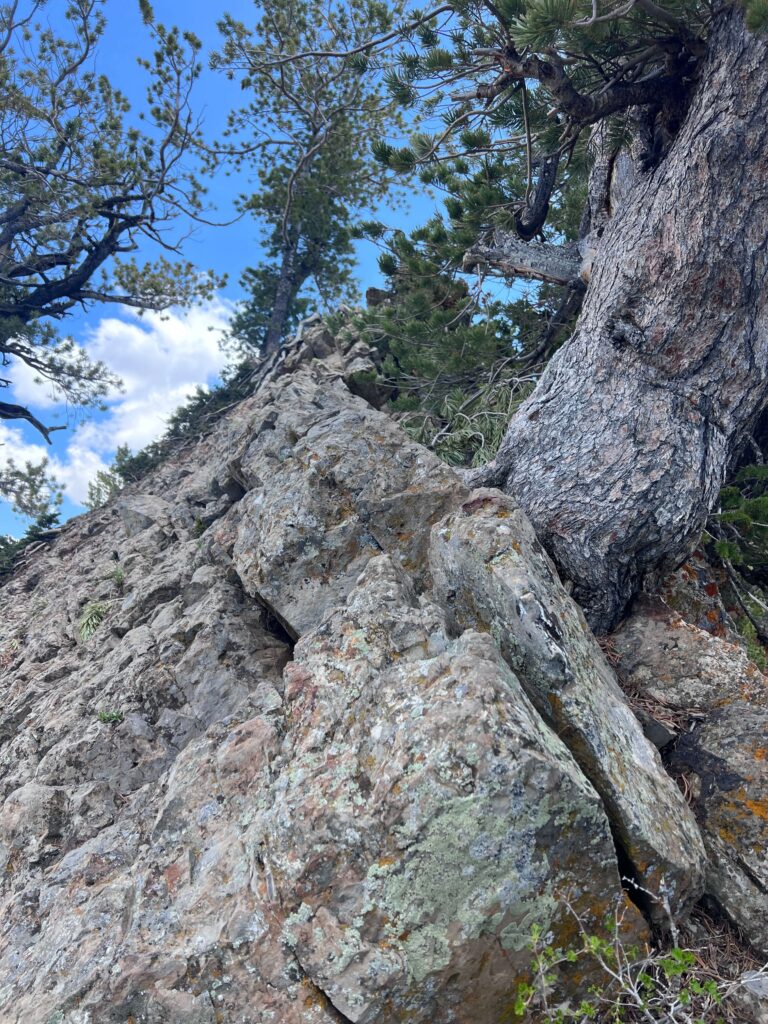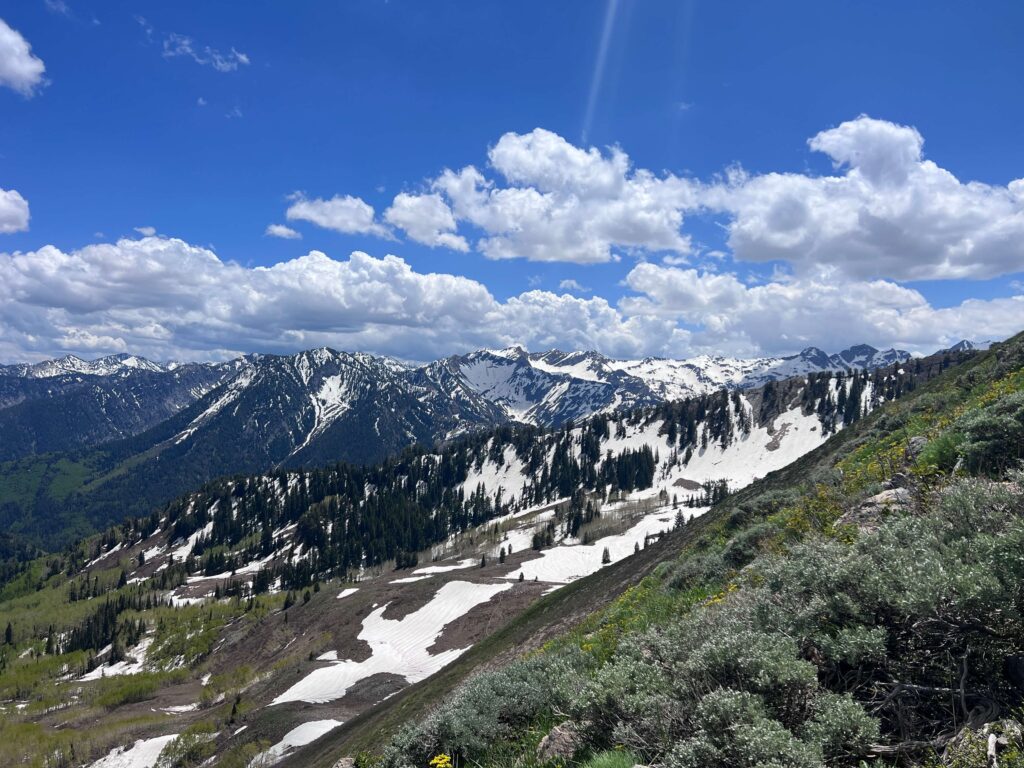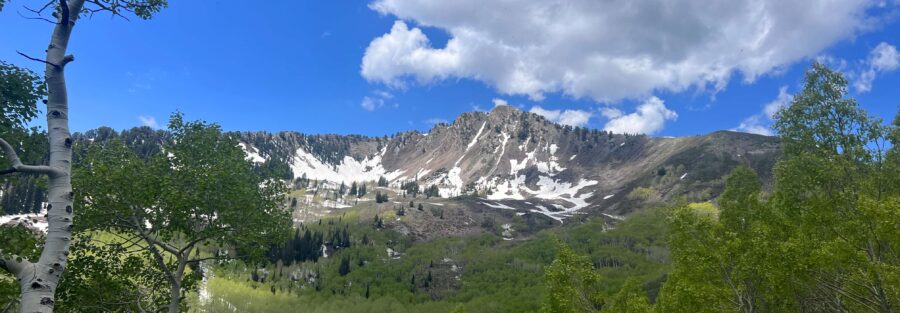Quick Facts:
Location: Mount Olympus Wilderness near Salt Lake City, Utah
Coordinates: 40.65004805803917, -111.66172560240588
Length: 7.5 Miles
Difficulty: Hard
Elevation Gain: 3,000 Feet
Dog Friendly: No
Introduction:
Mount Raymond, located in the Mount Olympus Wilderness near Salt Lake City, Utah, is a rewarding and challenging hike that offers stunning views, rugged terrain, and a sense of accomplishment that comes with summiting one of the Wasatch Range’s prominent peaks. Standing at 10,241 feet, Mount Raymond provides hikers with panoramic vistas of the surrounding mountains, valleys, and even glimpses of the Great Salt Lake. Whether you’re an experienced hiker seeking a new challenge or someone looking to immerse yourself in Utah’s natural beauty, the hike to Mount Raymond is a must do adventure.
How to Get There:
To reach the Mount Raymond trailhead, head towards Big Cottonwood Canyon, which is easily accessible from Salt Lake City. From the city, take I-215 to the 6200 South/Canyon Exit (Exit 6) and head east on UT-190, which becomes Big Cottonwood Canyon Road. Continue driving up Big Cottonwood Canyon for about 4.5 miles until you reach the Butler Fork Trailhead on the left side of the road. The trailhead is well-marked and is the starting point for several trails, including the route to Mount Raymond.
Parking Information:
Parking at the Butler Fork Trailhead is free, but the lot can fill up quickly, especially on weekends and during peak hiking season in the summer. Arriving early in the morning is recommended to secure a parking spot and to enjoy the trail before the midday heat sets in. There are no restrooms or other facilities at the trailhead, so be sure to prepare accordingly before starting your hike.

Description of the Landscape:
The hike to Mount Raymond takes you through some of the most stunning and diverse landscapes in the Mount Olympus Wilderness. The trail begins in a forest of aspen, pine, and fir trees, offering a shaded and serene start to the hike. As you ascend, the trail opens up to reveal expansive views of Big Cottonwood Canyon and the surrounding peaks. The path winds through alpine meadows filled with wildflowers in the summer, creating a vibrant and stunning scene.
As you approach the summit, the terrain becomes more rugged, with steep, rocky sections that require careful footing. The final push to the top involves a bit of scrambling, but the effort is well worth it. From the summit of Mount Raymond, you’ll be rewarded with breathtaking 360-degree views that stretch across the Wasatch Range, the Salt Lake Valley, and beyond. On clear days, you can even see the shimmering waters of the Great Salt Lake in the distance.
Trail Difficulty and Length:
The hike to Mount Raymond is considered challenging, with a combination of steep inclines, rocky terrain, and high elevation. The round trip from the Butler Fork Trailhead is approximately 7.8 miles, with an elevation gain of about 3,200 feet. The trail is well-marked but requires a good level of fitness and experience with more strenuous hikes. Hikers should be prepared for a demanding ascent, particularly in the final stretch to the summit, which involves some scrambling over rocky sections.
Dog-Friendly Information:
Unfortunately, Mount Raymond is not dog-friendly. As with all trails in Big Cottonwood Canyon, dogs are not allowed to protect the watershed that supplies drinking water to the Salt Lake Valley. If you’re looking to hike with your dog, consider exploring nearby Mill Creek Canyon, where dogs are allowed on most trails. Always check local regulations before heading out to ensure a safe and enjoyable experience for everyone.

Local Regulations:
When hiking in the Mount Olympus Wilderness, it’s important to follow local regulations to help preserve the area’s natural beauty. Stay on designated trails to minimize your impact on the fragile alpine environment, and avoid disturbing the local wildlife. As always, practice “Leave No Trace” principles by carrying out all trash and respecting the natural surroundings. The Mount Olympus Wilderness is a protected area, so be mindful of the rules and regulations to help keep this beautiful place pristine for future visitors.
Other Trails Nearby:
If you’re eager to explore more of the Mount Olympus Wilderness after summiting Mount Raymond, there are several other trails nearby that offer a variety of experiences. The Butler Fork Trail itself offers several branching routes, including the trail to Gobblers Knob, another challenging peak with rewarding views. The Lower Mill B North Fork Trail is a shorter, less strenuous hike that takes you to the beautiful Hidden Falls and offers stunning canyon views. For a longer adventure, the Mount Olympus Trail offers a challenging climb to one of the most iconic peaks overlooking the Salt Lake Valley.
Non-Hiking Attractions Nearby:
In addition to hiking, the area around Big Cottonwood Canyon and Salt Lake City offers a variety of attractions for visitors. Silver Lake at Brighton Ski Resort is a family friendly spot with a boardwalk trail around the lake, perfect for a leisurely stroll. The nearby Donut Falls is a popular destination for families and those looking for a shorter, scenic hike with a unique waterfall. In Salt Lake City, you can explore attractions such as the Utah State Capitol, Temple Square, and the Natural History Museum of Utah for a blend of culture, history, and natural beauty.

Accommodations: Where To Set Up Basecamp
If you’re looking for modern luxury right in the heart of downtown, the Hyatt Regency Salt Lake City is a top pick. With sweeping mountain views, stylish rooms, and an unbeatable location next to the Salt Palace Convention Center, it’s perfect for both adventurers and business travelers. You can unwind at the rooftop pool, grab a drink at the lively lobby bar, or step outside and find yourself within walking distance of Temple Square, City Creek shopping, and all the best food in town.
👉 Book your stay at Hyatt Regency Salt Lake City here and lock in the best available rates. Every booking through my link helps fuel more Unicorn Adventure road trips and photography journeys!
The Hilton Salt Lake City Center nails that classic downtown vibe with spacious rooms, great on-site dining, and a central location that makes exploring a breeze. Whether you’re catching a Broadway show at Eccles Theater, attending a convention, or heading up into the Wasatch Mountains for a quick hike, this hotel keeps you close to it all. Bonus: the indoor pool and fitness center are perfect for recharging after a long day.
👉 Reserve your room at Hilton Salt Lake City Center here and enjoy exclusive savings. Using my affiliate links directly supports my photography and storytelling while giving you the same great deals.
Best Time to Visit:
The best time to hike Mount Raymond is during the summer and early fall when the trail is free of snow and the weather is generally mild. Summer offers the chance to see wildflowers in full bloom and enjoy clear, sunny skies, while fall provides cooler temperatures and the opportunity to see the changing colors of the leaves. Spring hikes can be beautiful but may involve navigating snow and muddy conditions, particularly at higher elevations. Winter hikes are not recommended due to deep snow and the potential for avalanches, especially in the steep sections of the trail.
Support the Adventure
To make your walls less boring, check out my photography portfolio and bring a piece of the wild and my story into your home.
If you’d like to fuel future adventures, you can donate a coffee on Ko-Fi. Every cup keeps me chasing sunrises and stories.
When you shop using my affiliate links, every click helps support this blog at no extra cost to you. It’s a small way to keep Unicorn Adventure alive and kicking while I keep exploring.
Subscribe to my mailing list for future updates, new stories, and behind-the-scenes adventures.
Stay connected with me on Instagram and Facebook for more photos and daily inspiration.
Thanks for being part of the journey, Unicorn Squadron!


